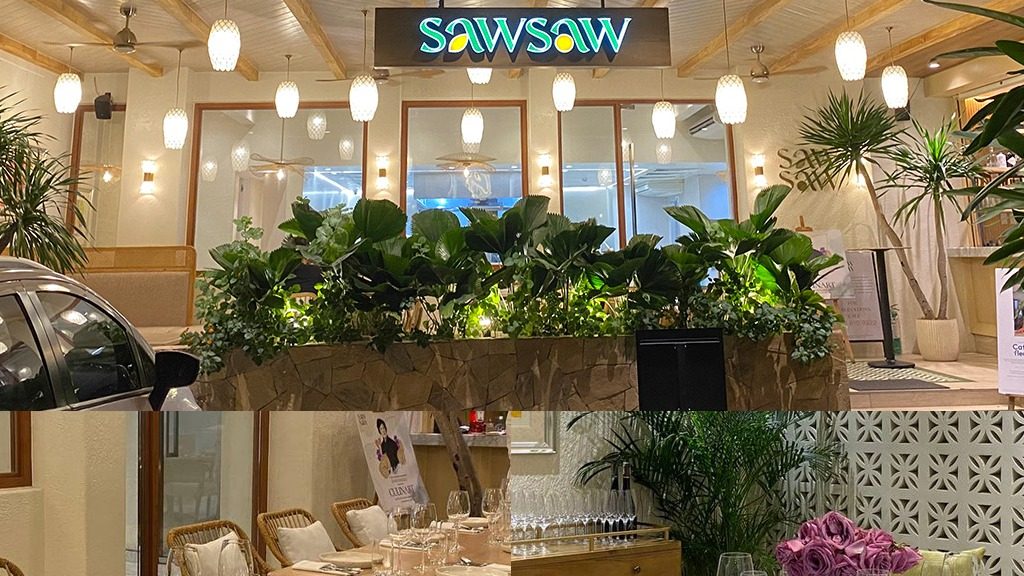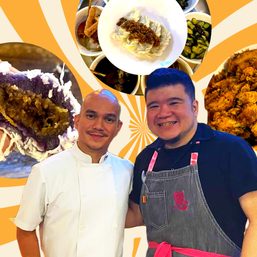SUMMARY
This is AI generated summarization, which may have errors. For context, always refer to the full article.

MANILA, Philippines – Behind a successful dream project is the passion, dedication, heart, and soul to see it through, and that’s what resonates in Chef Sau Del Rosario’s newest venture, Sawsaw.


Set along Makati City’s jam-packed Poblacion Street, the beautifully lit restaurant isn’t hard to miss. Sawsaw looks just like an upscale tropical resort (or a fancy beach rest house), adorned with Filipino accents like solihiya lamps, wooden chairs, and a cozy function room that looks just like your hip auntie’s living room.

It’s a classy yet laid-back space for Friday dinner dates or Sunday family dinners, with an open kitchen featuring young chefs working under Sau’s hands-on helm. The restaurant doesn’t feel stuffy or too high-end, and the outdoor patio and upper balcony are great areas to chill in with your crew.

BTW: It’s not a very spacious spot, so it’s best to reserve a table in advance. Also, the prices are steeper than your usual Pinoy restaurant, so allot a splurge-level budget for your meal.

Filipino food…again? What to expect
Sawsaw, which opened in June, is Pampanga-born Chef Sau Del Rosario’s newest baby, after putting up pandemic-born Cafe Fleur, which is also in Poblacion and under PYC Foods Group as well. SawSaw is different though, Chef Sau told Rappler. “This is really my own take on Filipino food,” he added.

“Enough of that elevated, modern, fusion…. I feel like we are misrepresented with those tiny-bit-of-food servings. If you try to modernize it too much, you lose the heart and that soul. You can’t relate anymore.”
French-trained and passion-driven, Chef Sau unearthed his favorite lutong bahay family recipes – “historical heritage passed down by my family” – and serves them in refined versions, using organic local produce and quality-sourced ingredients, and in shareable servings, just like you would at home.
“I believe that eating Filipino food should draw you back to your childhood, or even fond memories of travels. It’s a good feeling. Food is all about that,” he said. “The food here is very personal. Expect a lot of influences, techniques, but nothing to the extreme na molecular.”
SawSaw was a “dream project” in the making, always in the back of Chef Sau’s mind as he traveled around the world. Home had kept on calling him back. “The Philippines is where I belong, and my job is to pay it back – to prepare the younger generations for what Filipino food is all about.”
Sawsaw is his own personal journey across the Philippine regions, with each native dish “his own honest interpretation of Filipino food.” It is inspired by the name of the restaurant – sawsaw (to dip) into your own sawsawan (condiment). Aside from sawsawan being an important facet of Filipino dining culture, the sawsawan itself is a very personal way to enjoy food. One ulam on the family table can merit a variety of condiments, depending on your preferences – toyomansi (soy sauce and calamansi), patis with sili, or spiced suka, among many others!
“May personal touch talaga ang sawsawan (Condiments really have a personal touch to them) – kind of like adobo. Filipinos are like that, you change the recipe according to what is right for you. Filipino food is a kaleidoscope of flavors, textures, and cultural influences. It’s never one-size-fits-all, and that’s just the way we are. For me, to be successful with Filipino food, you just have to accept that fact.”
Sawsaw-rap
Sawsaw’s Filipino menu is varied enough that there’s a dish for everybody at the table – salads, soups, appetizers, meat entrees, seafood platters, cocktails, and even mocktails. As any Kapampangan chef would ensure, Chef Sau’s menu for the night started with sisig – through the Sisig Pie Tee (P525) appetizer.

This was the perfect starter for the night, and perhaps a foreshadowing of what was to come; the tiny, crisp cups filled with sisig and topped with calamansi pearls was a flavor explosion in my mouth.

In just one bite, all the best things about the Pampanga delicacy came to me: it was fatty, savory, tangy, and crunchy, with a subtle kick of spice. It was an addictive powerhouse of flavors, and rightfully so – Pampanga is home to the best sisig, after all.

The sisig cups were paired with Sawsaw’s gorgeous and refreshing Pako Salad (P675), made with the freshest native crisp fiddleheads, well-cooked shrimp, creamy kesong puti (carabao’s cheese), and punchy itlog na maalat (salted egg) – all the furnishings of a good pako salad, finished off with a light and tangy oil-based vinaigrette. This was a good palate cleanser to the indulgent sisig.

I’m all about maasim, so Sawsaw’s Kinilaw na Maya-Maya (P759) was another palate cleanser I looked forward to and enjoyed. The Philippines’ local ceviche included cubes of tender, buttery snapper bathed in a bright and zingy citrus dressing and fresh herbs, topped with ikura (salmon caviar) for a pop of alat. It was a clean and fresh take that wasn’t too acidic but still hit that signature asim-kilig spot.

Sawsaw’s Lumpiang Sugpo sa Sampalok Patis Dip (P695) was an interesting (and hefty) spin on the favorite lumpia. Crispy-fried, golden-brown wonton fortune bags had a slightly sweet, shrimp-filled stuffing inside, similar to a lumpia shanghai. The bagoong-like tamarind dip is salty-sour delicious as well. However, I couldn’t have more than one lumpia packet because it could get a bit too salty and filling, so I could do without this dish.

Chef Sau’s Inihaw na Pulpo (P850) is presented creatively; carefully sliced octopus in a Pinoy barbecue-like marinade is grilled at your table on a portable clay grill until deeply smoky, perfectly charred, and tender with a slight chew. You’re basically just getting pulpo here, so it’s best to pair this with a salad or even some rice.

Now onto the main event! I’m not a meat eater, but once I saw Sawsaw’s staff cut the 24-Hour Sous Vide Crispy Pata (P1,375) in front of my eyes…I couldn’t resist. Its crispy golden skin glistened and crunched as it was being chopped, revealing moist, fork-tender meat inside. Chef Sau uses UK pork knuckle, slow-cooked until all its natural, flavorful juices come out.


This was one of the best crispy patas I’ve tasted – it wasn’t too salty nor greasy or fatty, but it was still good enough to feel like a guilty pleasure. It’s served with three sawsawans, of course – toyomansi, atchara, and a homemade Mang Tomas dupe that’s sweeter than the original.

An equally decadent seafood entree is Sawsaw’s Lobster sa Alavar Sauce (P1,550), featuring Zamboanga City’s sauce specialty. It was hard to decide which element was the star here, but I think the smooth, rich, and creamy sauce made from coconut milk and taba ng talangka (crab fat) closely won over the fresh, high-quality, tender lobster used.
The almost melt-in-your-mouth lobster meat was very clean-tasting, which made it the perfect base to the thick alavar sauce doused on top that’s packed with umami richness. It’s one of the pricier dishes of the menu, but if you’re willing to #treatyourself, go for it.

Another creamy seafood dish was the Sugpo Bicol Express (P695), the famous Bicolano delicacy made with an authentic spicy-salty, creamy coconut sauce and green sili. My favorite part was the crispy sigarilyas bathed in the Bicol Express sauce – more so than the prawns actually, as they were a bit tough to cut through.

Last but definitely not the least was Sawsaw’s very memorable best-selling Lechon Baka “Sawsaw” Style (P1,250). Don’t be fooled by its simple presentation (and abundance of spring onions on top) – it’s your favorite Pinoy lechon baka, made 10x more tender with extra belly fat. Chef Sau uses US Wagyu Beef Belly for this dish, slow-roasted for hours in a Pinoy-style barbecue broth that’s beefy-savory, a tad sweet, and light enough to let that fork-tender wagyu beef shine. Carnivores, this is a must-try.

BTW: Sawsaw’s dishes are served with a simple side of sauteed veggies (wintermelon, turnip, chicharo, sitaw, kadyos beans, squash, onions) that are so well-seasoned and crisp that I asked for seconds!

Dessert time! Sawsaw served its favorite Bibingka Souffle (P575), a creative hybrid of the fluffy French pastry with the Filipino Simbang Gabi delicacy. The baked egg-based dish features a crisp exterior, gently cut in the middle by Sawsaw’s staff to make way for creamy, silky bibingka custard, which was poured inside the moist, soft pastry. It’s not an overly sweet dessert, as it still has the savory notes of a salted egg cheesy bibingka.

For your dose of kakanin, the Ube Macapuno at Leche Flan “Sapin Sapin” sa Dayap (P575) is a pretty collection of thick, ooey gooey ube jam beneath chewy macapuno balls, a serving of sweet-tangy leche flan, and coconut sugar to add a bit of texture.

Don’t miss out on the craft mocktails, too! We tried the refreshingly zingy Sawsaw Lemonade (P250) made with mango, passionfruit, and fresh lemon; Hibiscus Spritz (P295) made with hibiscus peppercorn-infused honey with soda water; and the Pineapple Cucumber Fizz (P295) made with ginger beer. Each one brought its own fruity and bubbly charm to the table.
At Sawsaw, Chef Sau made sure that his love for Filipino food and appreciation for the albeit colonized cuisine’s “spectrum of colors, flavors, and profiles” were present in his menu, without it being “too fancy and with no frills.”
Chef Sau said that Sawsaw isn’t “elevated Filipino food,” but to me, it kind of was, but not in a pretentious, “what-is-this?” way. Even if imported premium meats and refined techniques were used for certain dishes, the presentations and flavors were still familiar. Nothing felt alien. If you’re looking to enjoy comfort regional Filipino fare with a refined flair (and the budget to spare), Sawsaw by Sau is a worthy option, especially if you’re fine-casual dining with family or friends.
Sawsaw is located along Kalayaan Avenue, Makati City. It’s open daily from 10 am to 10 pm, except on Mondays. To reserve, you can call 09178109322 or message on Instagram. – Rappler.com
Add a comment
How does this make you feel?












![[OPINION] From ‘Puyat’ to ‘Tulog’: Clout-chasing street signs disrespected history](https://www.rappler.com/tachyon/2024/07/gil-puyat-july-26-2024.jpg?resize=257%2C257&crop=389px%2C0px%2C1080px%2C1080px)


There are no comments yet. Add your comment to start the conversation.